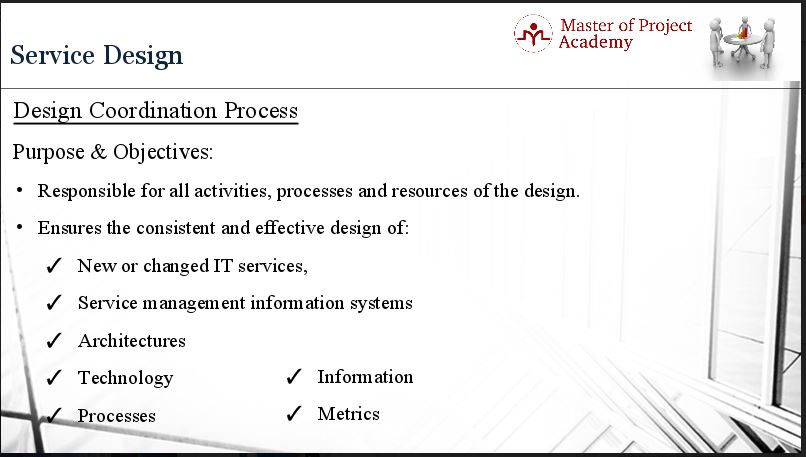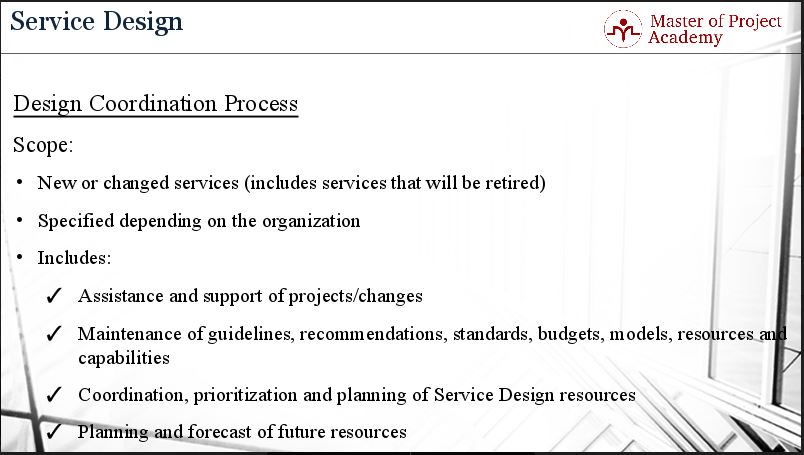The design coordination process is the final process in the ITIL service design stage of the ITIL lifecycle for services. Efficient and effective design coordination ensures that a service can successfully be handed over to the ITIL service transition stage, which is discussed in detail in ITIL online courses. The main goal of the this process is to coordinate all service design activities, processes, and resources.
In this post, we’re going to discuss this important process in detail. Specifically in regards to its goals, scope, sub-processes and relevant definitions within the ITIL framework. You can find sample questions about the process in many ITIL foundation practice exams as well.

The goal of the design coordination process
This process is responsible for all activities, processes, and resources of the design of services. There are several processes in service design stage. These processes interact with each other to create the service design package in the end. And these processes are completed with resources including capital, people, technology, tools etc. In order to ensure an efficient and effective management of the service design processes, coordination and interaction of these processes are done with the help of design coordination process.

Thisprocess ensures the consistency and effective design of:
- New or changed IT services
- Service management information systems
- Architectures
- Technology
- Processes
- Information
- Metrics
Definitions in the design coordination process
The following ITIL terms and acronyms are used in ITIL design coordination to represent process outputs and inputs:
Service Design Package (SDP)
The Service Design Package builds upon the service level requirements. It further specifies the requirements from the viewpoint of the client and defines how these are actually fulfilled from a technical and organizational point of view.
Service Design Policy
The Service Design Policy provides guidance on how to ensure that a consistent approach is applied to all design activities. In particular, the service design policy specifies which projects or changes are required to undergo the formal service design stage, and who needs to be involved in service design to ensure that all relevant aspects are considered.
The scope of Design Coordination process
The design coordination process contains new and changed services including services to be discontinued. As we have seen in previous posts, service management does not include only new or changes to existing services. Services that will not be provided to the customers anymore have to be retired properly in the context of ITIL service management as well.
The scope of this process is specified based on the organization of the company. Each company has different objectives, vision, and strategy. Therefore, each company will have a different service design strategy and this will require changes in the service design processes as well. Therefore, the scope of the design coordination process varies depending on the organization.

Design Coordination process includes assistance and support of the project, or changes. Each project or change will require initiation of a process in service design respectively. The coordination of the interactions between processes in service design is established by design coordination process. This includes the maintenance of guidelines, recommendations, standards, budgets, models, resources and capabilities for design processes and activities. It also deals with the coordination, prioritization, and planning of Service Design resources. In addition, planning and forecast of future resources are done in the scope of the design coordination process.
Since the design coordination process coordinates and manages the interaction of all design, processes, review, measurement and improvement of service design is also in the scope of design coordination process.
Sub-processes of the design coordination process
Design coordination support
The process objective is to coordinate and develop service design resources and capabilities, and to ensure that a consistent approach to designing new or changed services is adopted across all service transition projects. The service design manager is accountable as well as responsible for this process.
Service design planning
The process objective is to plan design activities in detail, making sure that all relevant aspects are considered during service design. Planning is often the most important part of any process. Without proper planning, many things can that were unaccounted for can happen and no contingency plan would be in place to deal with problems that were not anticipated. The service design manager is accountable and partially responsible for this process. The project owner is also responsible for this process.
Service design coordination and monitoring
The process objective is to coordinate the design activities performed by various service design processes, and to determine if the new or changed service can be provided economically. This process is also responsible for deciding if the clients’ requirements can be fulfilled or must be renegotiated. The service design manager is accountable for this process while the IT operations manager and financial manager are responsible for this process.

Technical and organizational service design
The process objective is to determine how a new service will be provided from an IT perspective. In particular, this means to specify any technical infrastructure to be created, as well as required organizational changes. The resulting service design package contains all relevant information for Service Transition. The service design manager is accountable for this process.
Service design review and request for change submission
The process objective is to submit the service design package to a final review and initiate the implementation of the service by submitting a formal Request for Change. This is where the ITIL service design stage meets the ITIL service transition stage in the ITIL lifecycle. The service design manager is responsible and accountable for this process.
The Service Design Manager is responsible for producing quality, secure and resilient designs for new or improved services. This includes producing and maintaining all design documentation. The service design manager is involved throughout the service design coordination process, either by being accountable for a sub-process or being responsible for the sub-process to be completed efficiently and effectively. The service design coordination process is the final process in the service design stage of the ITIL service lifecycle.
Review by: Earl Garrett
